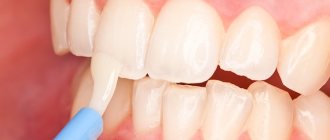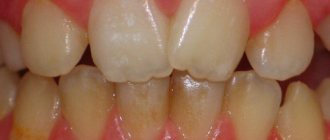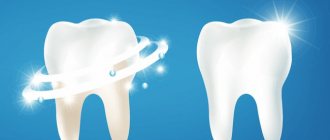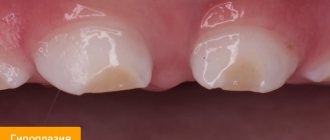Author of the article:
Soldatova Lyudmila Nikolaevna
Candidate of Medical Sciences, Professor of the Department of Clinical Dentistry of the St. Petersburg Medical and Social Institute, Chief Physician of the Alfa-Dent Dental Clinic, St. Petersburg
At any age, a person can face such a problem as discoloration of tooth enamel. There are several reasons for this phenomenon, but one of the most common is fluorosis. Uneven coloring of the enamel disrupts the aesthetics of a smile and causes certain psychological discomfort during communication. One of the methods for restoring aesthetics in case of discoloration is microabrasion. We'll talk about what this method is and what indications there are for microabrasion of tooth enamel.
Fluorosis as the main indication for microabrasion
Dental fluorosis is a chronic disease that affects tooth enamel due to excessive accumulation of fluoride in the human body. The main cause of the development of the disease is long-term use of water and toothpaste with a high content of fluoride compounds. With fluorosis, enamel discoloration occurs, which manifests itself in the form of spots. The problem mainly affects children at the stage of formation of permanent teeth.
This problem especially concerns residents of endemic areas. In Russia, these are the Leningrad region, the Republic of Mordovia, the Nizhny Novgorod region, the Urals, and Western Siberia. In these regions, the concentration of fluoride in ordinary water exceeds sanitary standards (>1.5 μg/l). This also includes natural springs and artesian wells. In addition, in many cities, water is fluoridated for prevention. The danger of fluorides is that they accumulate not only in teeth, but also in bones, and if accumulated in excess, they can even lead to bone cancer - osteosarcoma.
The disease occurs in 3 stages:
- mild form of the lesion - small chalky spots and stripes on the surface of individual teeth;
- moderate damage - pigmented spots of yellow or brown color are added, covering several teeth;
- severe form - almost the entire tooth is covered with brown spots, while the crown of the tooth is deformed, the enamel is erased or chipped.
Enamel microabrasion is used only for mild or moderate fluorosis (spotted and chalky-mottled forms). But the indication for the procedure is not only fluorosis.
Advantages of the method
The procedure is simple to perform and can be used on permanent teeth in adults and adolescents (which cannot be said about whitening). In case of superficial enamel discoloration, microabrasion allows you to quickly and painlessly achieve good results, making your teeth aesthetically more attractive, white and shiny. Another advantage is that the procedure, if the tooth is intact and has not undergone severe destruction, helps to avoid more invasive intervention and refuse the installation of orthopedic structures. For example, crowns.
Before and after the operation
A number of studies suggest that hard tissues subjected to microabrasion are less susceptible to demineralization processes than those that were not treated. They show less colonization of carious bacteria, the main causative agents of caries - Streptococcus mutans.
Contraindications
The procedure is not recommended under certain conditions:
- tetracycline staining;
- moderate enamel underdevelopment;
- age-related staining;
- severely thinned enamel, cracks and erosive defects;
- wedge-shaped defects;
- exposed necks of teeth;
- severe form of fluorosis;
- pathologies of oral tissues;
- pulpless teeth.
Microabrasion is contraindicated for women during pregnancy and lactation. In addition, the procedure is not performed on baby teeth.
How does the procedure work?
Previously, eliminating cosmetic smile defects was possible only through the use of composite materials and the installation of crowns. Modern technologies make it possible to get rid of uneven staining of teeth without boron preparation; one of these technologies is microabrasion, or micro-abrasive treatment. The essence of the method is to grind off a microscopically thin layer of enamel, followed by polishing. Thus, this is not a therapeutic event, but a cosmetic one.
Due to the fact that the impact is only on the upper layers of enamel - the thickness of the removed layer is usually no more than 0.2 mm - this procedure does not lead to serious irreversible consequences. Microabrasive treatment minimally changes the contours of the enamel surface and is a more conservative method than tooth restoration with composite materials.
Microabrasive treatment does not require anesthesia, as it is painless. Before the procedure, the doctor decides on the need for professional hygiene. The dentist then determines the patient's natural enamel shade using the standard Vita scale and creates a treatment plan. The patient's eyes are protected with glasses.
Algorithm for the procedure:
- isolation of the working field using a rubber dam. Performed to protect the mucous membrane;
- applying an abrasive mixture to the surface of the tooth being treated and rubbing it in using slowly rotating attachments - cups. For microabrasion, the drug Opalustre is used, which contains microparticles of silicon carbide and 6.6% hydrochloric acid;
- rinsing off If the result is positive, move on to the next stage, if not, repeat the previous one;
- polishing the tooth surface with fine fluoride paste to achieve an optimal aesthetic result;
- registration of color changes.
As a rule, one visit to the clinic is enough to eliminate enamel discoloration. The best results are achieved by a combination of microabrasion and clinical bleaching.
Microabrasion results
At the end of the procedure, the patient receives a uniform shade of enamel and lightens the teeth by a couple of tones. It has been clinically confirmed that such manipulation is absolutely harmless to the body and does not lead to complications. The only point: 8% of patients may experience increased sensitivity of the enamel. But don’t panic, this is considered to be the norm. The doctor gives the necessary recommendations and soon this symptom disappears without a trace. As a result, you can get not only an aesthetic result, but also protect the tooth from further destruction due to caries.
Efficiency and safety
Microabrasion allows you to get rid of enamel discoloration. As a result, not only the appearance of the tooth improves, but its further destruction is stopped. In addition, micro-abrasive treatment allows you to avoid tooth grinding and restoration using expensive composites. After the procedure, age spots do not return.
Efficiency depends on the degree of damage: microabrasion helps either completely eliminate surface stains on the enamel or mask discolored areas. Provides a natural glossy shine to the enamel surface. The result is noticeable immediately after the procedure.
The main complication after the procedure is increased tooth sensitivity. To eliminate it, it is recommended to use special toothpastes and rinses for sensitive teeth, for example, low-abrasive ASEPTA Sensitive toothpaste. Additionally, it is necessary to use remotherapy products as an opportunity to mineralize damaged areas, for example, ASEPTA Plus Remineralization. This professional toothpaste restores weakened and damaged enamel, saturates it with essential macro- and microelements.
Stages of microabrasion
One of the advantages of this procedure is that it is painless, so microabrasion does not require painkillers. The main thing is to sit comfortably in the dental chair and prepare yourself mentally for a good result. It is very important to sit still so as not to interfere with the doctor's work. So, let's move on to the stages of this manipulation:
- Carrying out ultrasonic cleaning.
- Use of rubber dam.
- A composition with abrasive particles is applied to the enamel and left for some time. The duration is determined individually, it depends on the condition of the teeth.
- After time has passed, the composition is removed.
- The next stage is the application of a special gel, which prevents increased sensitivity and helps fill the tooth tissue with useful microelements.
- Additionally, fluoridation of teeth can be carried out, but this issue is decided on an individual basis.
- Next, the specialist advises on further care and maintaining the result.
Clinical researches
ASEPTA products are clinically proven effective. For example, repeated laboratory tests have proven that regular use of preventive toothpaste ASEPTA SENSITIVE for a month can reduce bleeding gums by 62%, reduce sensitivity of teeth and gums by 48% and reduce inflammation by 66%.
Clinical studies have proven that regular use of professional toothpaste ASEPTA REMINERALIZATION improved the condition of the enamel by 64% and reduced tooth sensitivity by 66% after just 4 weeks.
Sources:
- Report on determining/confirming the preventive properties of toothpaste “ASEPTA PLUS” GENTLE WHITENING” Author: doctor-researcher A.A. Leontyev, head Department of Preventive Dentistry, Doctor of Medical Sciences, Professor S.B. Ulitovsky First St. Petersburg State Medical University named after. acad. I.P. Pavlova, Department of Preventive Dentistry
- Clinical and laboratory assessment of the influence of domestic therapeutic and prophylactic toothpaste based on plant extracts on the condition of the oral cavity in patients with simple marginal gingivitis. Doctor of Medical Sciences, Professor Elovikova T.M.1, Candidate of Chemical Sciences, Associate Professor Ermishina E.Yu. 2, Doctor of Technical Sciences Associate Professor Belokonova N.A. 2 Department of Therapeutic Dentistry USMU1, Department of General Chemistry USMU2
- Clinical studies of antisensitive toothpaste “Asepta Sensitive” (A.A. Leontyev, O.V. Kalinina, S.B. Ulitovsky) A.A. LEONTIEV, dentist O.V. KALININA, dentist S.B. ULITOVSKY, Doctor of Medical Sciences, Prof. Department of Therapeutic Dentistry, St. Petersburg State Medical University named after. acad. I.P. Pavlova
- The role of anti-inflammatory rinse in the treatment of periodontal diseases (L.Yu. Orekhova, A.A. Leontyev, S.B. Ulitovsky) L.Yu. OREKHOVA, Doctor of Medical Sciences, Prof., Head of Department; A.A. LEONTIEV, dentist; S.B. ULITOVSKY, Doctor of Medical Sciences, Prof. Department of Therapeutic Dentistry of St. Petersburg State Medical University named after. acad. I. P. Pavlova
- Report on determining/confirming the preventive properties of toothpaste “ASEPTA PLUS” COFFEE and TOBACCO Author: doctor-researcher A.A. Leontyev, head Department of Preventive Dentistry, Doctor of Medical Sciences, Professor S.B. Ulitovsky. First St. Petersburg State Medical University named after. acad. I.P. Pavlova, Department of Preventive Dentistry
- Report on determining/confirming the preventive properties of commercially produced personal oral hygiene products: Asepta toothpaste used in combination with Asepta mouthwash and Asepta gum balm Head. Department of PFS Doctor of Medical Sciences Professor S.B. Ulitovsky St. Petersburg State Medical University named after Academician I.P. Pavlova. Faculty of Dentistry. Department of Preventive Dentistry.
Prevention of fluorosis
To prevent the development of fluorosis in children living in a risk zone, it is necessary to transfer the newborn from breastfeeding to complementary feeding as late as possible; in the future, it is necessary to provide the child with a balanced diet, and, if possible, replace water with milk.
Additional intake of calcium and phosphorus will also help to avoid fluoride oversaturation, since it is these microelements that help remove it from the body. It will be useful to send your child on vacation to various health camps, to visit relatives in other regions, in order to temporarily change the water source. Toothpaste, rinses and flosses for the oral cavity for fluorosis and for its prevention should be chosen without fluoride compounds. It is especially important to exclude the use of fluoride toothpastes in children, since children do not yet know how to brush their teeth properly and swallow part of the toothpaste.
Fluorosis is a disease of the skeletal system and teeth, which can be acquired at any age. But the main risk of development still occurs in the period before the eruption of permanent teeth. All preventive measures will be 100% effective until the enamel of molar teeth in children is fully formed.











